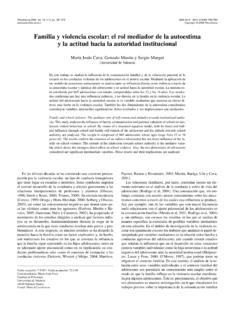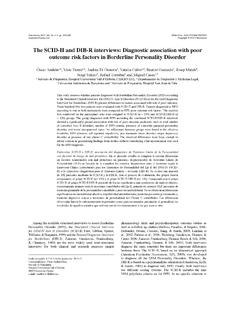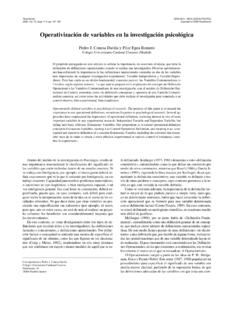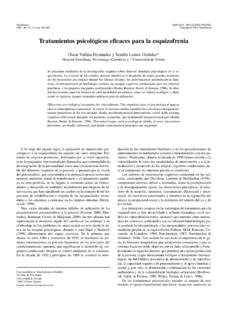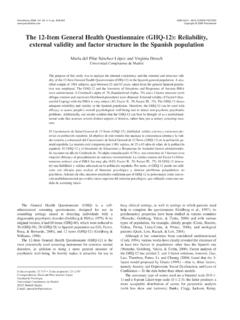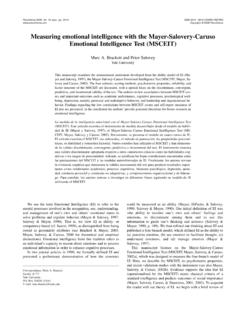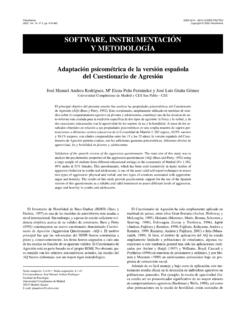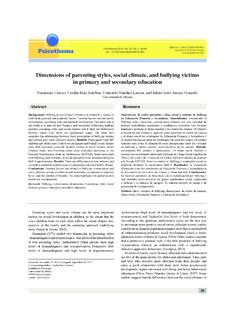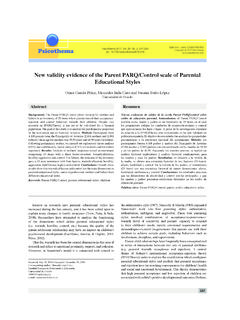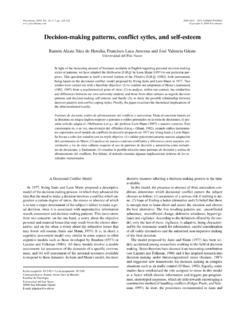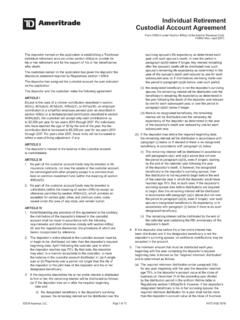Transcription of The effects of custodial vs non-custodial sanctions …
1 The authors have just finalised a systematic review on theeffects on re-offending of custodial and non- custodial ( alternative ) sanctions (Villettaz, Killias, & Zoder, 2006). Sincethe mid-19thcentury, it was common knowledge, if not a dogma,that short-term imprisonment is damaging because, in the wordsfirst coined by Bonneville de Marsangy and later copied by vonLiszt and many others, incarceration for shorter periods does notlast long enough to cure criminal propensities (seen as a kind ofa disease), but still too long to avoid first-time offenders to beexposed to the risk of contamination by hard-core criminals(Kuhn, 2000). Based on this quasi-medical theory of criminalcontamination, von Liszt and many others ever since havestimulated the development of sanctions that do not imply custody,such as suspended sentences, probation, fines and later communitywork and electronic monitoring. Simultaneously and ratherironically, the same movement has also stimulated long-termincarceration and even incapacitation for offenders considered assufficiently sick to warrant long-term cures in these trends have been stimulated by the idea to offer better alternatives to custody, to reduce re-offending through moreefficient alternative sanctions .
2 Many such programs have beenevaluated over the last decades world-wide, usually with resultsthat confirmed the superiority of non- custodial over custodialsanctions. Keeping these backgrounds in mind, the CampbellCollaboration Crime and Justice Groupinvited the authors to starta systematic review of the evidence on whether or not custodial ornon- custodial sanctions are more effective in preventing re-offending. This essay will give a resume of the methods andresults of this meta-analysis. We shall conclude with an overviewon how future evaluations of new sanctions and programmescould be made more effects of custodial vs non- custodial sanctions on reoffending:Lessons from a systematic reviewMartin Killias and Patrice VilletazUniversity of Lausanne (Switzerland)Based on a systematic review of some 23 (out of 300 originally located) studies, it is concluded thatmost studies show lower rates of re-offending following a non- custodial compared to a custodial sanc-tion.
3 However, this outcome may be biased because, in most quasi-experiments of this kind, subjectswith the worst prospects of rehabilitation are likely to be sent to prison. In a meta-analysis limited tofive randomised controlled trials and one natural experiment, it is concluded that custodial and non- custodial sanctions do not differ significantly in terms of re-offending. Lessons from this review in-clude, in view of future evaluations, the need to increase randomised controlled trials, to use broadermeasures of re-offending and rehabilitation, to look at long-term effects , and to deal with possibleHawthorn effects . Equal rates of re-offending do not mean that nothing works or nothing matters ,but that criminal justice policies should not be based on the belief that short-term confinement will efectos de las penas privativas vs no privativas de libertad en la reincidencia: lecciones de una re-visi n sistem una revisi n sistem tica de 23 estudios se concluye que la mayor a de las in-vestigaciones muestra una tasa m s baja en la reincidencia de los delincuentes condenados a cumpliruna condena alternativa a la prisi n, comparados con los que son condenados a penas de reclusi n.
4 Noobstante, esta estimaci n puede estar sesgada, debido al hecho de que los sujetos que tienen el peorpron stico de rehabilitaci n son los que suelen ingresar en prisi n. En un meta-an lisis que realizamosde cinco estudios que inclu an dise os experimentales con asignaci n al azar, m s un experimento na-tural, obtuvimos el resultado de que las condenas de reclusi n y las penas alternativas no difieren demodo significativo en cuanto a la reincidencia. El art culo a continuaci n deriva algunas conclusionesde la investigaci n, entre las cuales se citan las siguientes: la necesidad de aumentar el n mero de ex-perimentos con asignaci n al azar, emplear medidas m s inclusivas de la reincidencia y la rehabilita-ci n, y estudiar los efectos de las sanciones a m s largo plazo .Que se obtengan tasas iguales de rein-cidencia no significa que nada funciona , sino que la pol tica criminal no deber a asumir que,necesariamente, la reclusi n breve en la c rcel tendr efectos negativos en el recepci n: 19-6-07 Fecha aceptaci n: 11-9-07 Correspondencia: Martin KilliasEcole des Sciences CriminellesUniversity of LausanneCH-1015 Lausanne (Switzerland)E-mail: 2008.
5 Vol. 20, n 1, pp. 29-34 ISSN 0214 - 9915 CODEN 2008 PsicothemaMethodWhat is custodial ? What is non- custodial ?According to the protocol, the systematic review was to includeworld-wide published or unpublished studies conducted between1961 and 2002 where some form of non- custodial sanction hasbeen compared, in terms of re-offending, with custodial sanctions . For pragmatic reasons, sanctions were considered custodial whenever they were imposed by a judge, as a form ofpunishment (with or without treatment ), thus excluding pre-trialdetention and arrest policies ( in connection with domesticviolence), and whenever they implied some form of confinementin a closed residential setting. sanctions were considered non- custodial whenever they did not imply deprivation of to our pragmatic definition, boot camps or sentencesimplying deprivation of liberty in a closed therapeutic setting havebeen considered as custodial , whereas community work,electronic monitoring, financial or suspended sanctions (probation) have been considered as alternative or non- custodial .
6 Given the large international differences in crimepolicies, but also changes since the 1960ies in character andtypologies of prisons and other sanctions , we are aware of somedifficulties in this respect. Practically, however, we guess that thenumber of studies on sanctions at the margin of what one mightconsider custodial or not was not particularly large. Moreserious was the heterogeneity of alternative sanctions , since thisconcept included sanctions as different as community service,probation, fines and electronic monitoring. The only commondenominator was that all these sanctions did not involvedeprivation of liberty. We are aware that this is a questionablecategory. On the other hand, it is certainly not irrelevant forassessing the claim that confinement is damaging per se. Finally,the duration of custody and alternative sanctions can varyconsiderably, whereas virtually all studies included compared any alternative to rather short prison terms.
7 Again, this is not aproblem in a context where the century-old claim has always beenthat short-term confinement is damaging. But we recognise thatone may legitimately question whether longer prison terms areequally (or more or less) damaging (a question addressed by themeta-analysis by Smith, Goggin, & Gendreau, 2002). To beeligible, studies had also to offer some results on re-offending,however quality of studiesA far more difficult choice was to select studies according tomethodological quality. Originally, we had in mind to consideronly randomised or natural experiments and quasi-experimentswhere important intervening variables had been controlled for thatwent beyond what one usually finds in criminal records (such asnumber and kind of previous convictions and offences, plus ageand gender); in particular, we thought that a certain number ofstudies might have considered also education, employment recordand drug or alcohol abuse history.
8 To our surprise, we rapidlyrealised that there were only four randomised controlled trials, onenatural experiment (van der Werff 1979, 1981), but, despitehundreds of studies, almost no quasi-experiments where theseadditional requirements had been satisfied. This led us to abstractin full some 50 studies (out of 3,000 screened abstracts and some300 studies that seemed, at first sight, relevant to our review ), butto select only 23 for our systematic review . This selection process raised a difficult choice between internaland externalvalidity. Meta-analyses and systematic reviews aredesigned to overcome limitations to external validity of studieswhose scope has been limited in time and space, as is the case ofvirtually all randomised controlled trials. On the other hand, theinternal validity of most quasi-experiments is highly questionablein this field, since judges or correctional officers who have todecide whether a defendant is to serve his sentence in prison or inany alternative arrangement are regularly told, either by law orinternal guidelines, to consider the defendant s risk of re-offendingor, as often phrased, his need for treatment.
9 In assessing suchrisks, they typically pay attention to many individualcharacteristics that go far beyond what they may find in a criminalrecord, namely his employment record, the family situation, hissubstance abuse history and many other variables that are typicallyhard to measure, including intuition. These factors are, later, againtypically related to recidivism. In evaluations where, as usual,subjects with the worst prediction records were systematically sentto prison, while all others were eligible for an alternative , re-offending will, almost by necessity, be more frequent among thoseserving their sentence in confinement. As observed by Walker,Farrington & Tucker (1981) 25 years ago, such differences (infavour of non- custodial sanctions ) typically vanish the moreindependent variables are being controlled. Since such controlsrarely include variables beyond what can be found in criminalrecords, as mentioned, much variance in re-offending regularlyremains unexplained, often beyond 70 and up to 80 percent, a factthat points to a wide array of uncontrolled factors in recidivism.
10 Ina situation like this, including in a meta-analysis quasi-experimental studies whose outcomes tend to be systematicallybiased in one direction will likely reproduce the same bias. Ifsystematic reviews increase external validity, they shouldobviously not achieve this at the costs of internal , it has been decided to restrict the meta-analysis to fourrandomised controlled experiments and the one naturalexperiment whose internal validity seems beyond doubt. ResultsIf all the 23 studies with at least 4 control variables were counted , the result was clearly favourable to non-custodialsanctions. In 11 out of 27 possible comparisons, re-offending wassignificantly more frequent after a custodial sanction, whereas theopposite outcome was observed only in 2 cases. Thus, the votecount method clearly favoured alternative sanctions overimprisonment. In the case of the meta-analysis, however, no significant meanstandardised effect size has been observed, although the trend hasbeen slightly in favour of alternative sanctions again.
